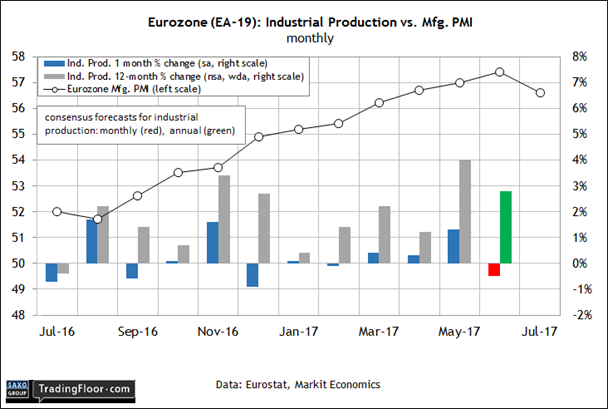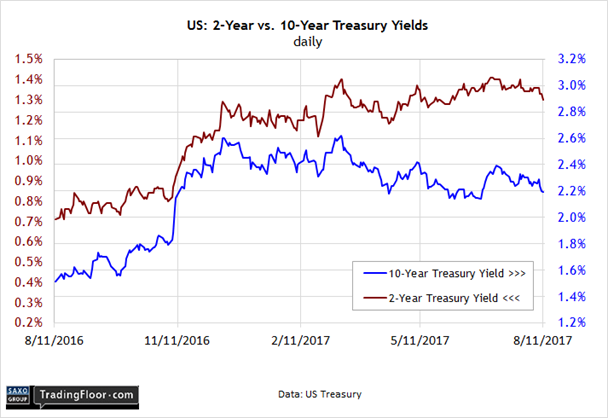- Euro area industrial production expected to fall for first time in four months
- Brent Oil stabilises as the recent gap between supply and demand narrows
- Soft inflation and North Korea worries weigh on the 10-Year Treasury yield
- As long as tension persists over Korea, Treasury yields will probably stay low
Eurozone industrial production in June is the main event for scheduled economic data today. Meanwhile, keep your eye on Brent oil, which traded in a tight range last week amid bullish news of a narrowing gap between supply and demand. Another key market to watch: the benchmark 10-year US Treasury yield, which fell to a two-month low on Friday.
Eurozone: Industrial Production (0900 GMT) Firmer economic growth in the euro area has been lifting key indicators this year, including the monthly numbers for industrial production. But today’s update for June is expected to show the first round of weakness in four months.
TradingEconomics.com’s consensus forecast sees output slipping 0.5% for the monthly comparison at the end of the second quarter. If correct, production will post the first monthly decline since February and the steepest setback this year. The year-on-year trend will suffer, too, but continue to post modest growth, rising 2.8% vs. the year-earlier level, according to economists.
Recent survey data for the manufacturing sector, the primary source of economic activity for the industrial data, also hints at a slowdown for growth. The IHS Markit Eurozone Manufacturing PMI dipped to 56.6 in July, pointing to “a slight moderation in the recent strong rate of expansion”, the consultancy noted earlier this month.
Nonetheless, “national surveys pointed to broad-based growth, with PMI readings for all eight of the countries monitored signalling expansion,” the consultancy advised.
Given the still-encouraging backdrop, weakness in today’s hard data for June should be considered a temporary pause in an otherwise ongoing recovery for the Eurozone economy.

Brent Crude Oil Analysts last week advised that the imbalance between supply and demand is moving back into balance, providing a degree of support for keeping Brent crude oil above the $50 mark in recent days.
One sign that equilibrium may be returning is the return of backwardation in the structure of oil futures. In midday trading on Friday, near-term contracts for Brent were priced above contracts with expirations further out in time – a profile that suggests that supply and demand are moving closer to equilibrium. The spread between the first less the second-month contract, for instance, turned positive last week for the first time in more than a year.
“The rebalancing of the oil market is happening, with demand catching up with supply,” an analyst at HSH Nordbank told Bloomberg.
Although excess US supplies growth and inventories remain a headwind for oil prices in the short term, Alliance Bernstein on Friday advised in a report that “we remain confident that over the longer term the market is headed in the right direction and supply and demand imbalances will eventually pull oil back up to marginal cost.”
A key question for traders this week: will Brent prices break out of the tight range that’s kept crude trading between roughly $51 and $53 in recent days? A relative calm has prevailed lately, perhaps due to the expectation that fundamentals are stabilising.
One wild card is the weak compliance among Opec members to adhere to a recent agreement to cut production. “There would be more confidence that rebalancing is here to stay if some producers party to the output agreements were not, just as they are gaining the upper hand, showing signs of weakening their resolve,” noted the International Energy Agency last week.

US: 10-Year Treasury Yield The benchmark 10-year rate fell to its lowest level since June at last week’s close, due to rising tensions between the US and North Korea and soft inflation data.
The rush into safe-haven Treasuries may be temporary, depending on how the war of words unfolds in the days ahead between US President Donald Trump and the hermit kingdom. But the sharp slide in the benchmark yield shows the potential for military action is being taken seriously by investors.
The latest inflation report added downside pressure to rates. On Friday, the government reported that consumer prices rose less than expected in July, offering a new reason to wonder if the news will convince the Federal Reserve to delay its plans to continue raising interest rates.
Headline inflation ticked up to 1.7% in annual terms, although that’s still below the central bank’s 2.0% target. Core inflation (excluding food and energy) also increased 1.7% vs. the year-earlier level in July, matching the pace in the previous month.
Fed Chair Janet Yellen recently advised that the soft inflation rate would soon firm up. The New York Fed President Bill Dudley, however, managed expectations down last week, noting that “I do think inflation will start to move higher in the medium term, but probably not get all the way back to 2% on a year-on-year basis.”
Regardless, as long as the crowd remains on edge over the North Korea threat, supported by low inflation prints, Treasury yields will probably stay low, providing the Fed with an excuse to put plans for more monetary tightening on hold.

Disclosure: Originally published at Saxo Bank TradingFloor.com
